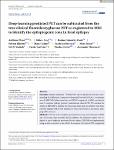Deep-learning predicted PET can be subtracted from the true clinical fluorodeoxyglucose PET co-registered to MRI to identify the epileptogenic zone in focal epilepsy
| dc.contributor.author | Flaus, Anthime | |
| dc.contributor.author | Jung, Julien | |
| dc.contributor.author | Ostrowky‐Coste, K | |
| dc.contributor.author | Clauhs, Matthew | |
| dc.contributor.author | Guénot, M | |
| dc.contributor.author | Bouvard, S | |
| dc.contributor.author | Janier, M | |
| dc.contributor.author | Yaakub, Siti Nurbaya | |
| dc.contributor.author | Lartizien, Carole | |
| dc.contributor.author | Costes, N | |
| dc.contributor.author | Hammers, A | |
| dc.date.accessioned | 2023-11-28T10:20:28Z | |
| dc.date.available | 2023-11-28T10:20:28Z | |
| dc.date.issued | 2023-08-29 | |
| dc.identifier.issn | 2470-9239 | |
| dc.identifier.issn | 2470-9239 | |
| dc.identifier.uri | https://pearl.plymouth.ac.uk/handle/10026.1/21722 | |
| dc.description.abstract |
Objective Normal interictal [18F]FDG-PET can be predicted from the corresponding T1w MRI with Generative Adversarial Networks (GANs). A technique we call SIPCOM (Subtraction Interictal PET Co-registered to MRI) can then be used to compare epilepsy patients' predicted and clinical PET. We assessed the ability of SIPCOM to identify the Resection Zone (RZ) in patients with drug-resistant epilepsy (DRE) with reference to visual and statistical parametric mapping (SPM) analysis. Methods Patients with complete presurgical work-up and subsequent SEEG and cortectomy were included. RZ localisation, the reference region, was assigned to one of eighteen anatomical brain regions. SIPCOM was implemented using healthy controls to train a GAN. To compare, the clinical PET coregistered to MRI was visually assessed by two trained readers, and a standard SPM analysis was performed. Results Twenty patients aged 17-50 (32 ± 7.8) years were included, 14 (70%) with temporal lobe epilepsy (TLE). Eight (40%) were MRI-negative. After surgery, 14 patients (70%) had a good outcome (Engel I-II). RZ localisation rate was 60% with SIPCOM vs 35% using SPM (P = 0.015) and vs 85% using visual analysis (P = 0.54). Results were similar for Engel I-II patients, the RZ localisation rate was 64% with SIPCOM vs 36% with SPM. With SIPCOM localisation was correct in 67% in MRI-positive vs 50% in MRI-negative patients, and 64% in TLE vs 43% in extra-TLE. The average number of false-positive clusters was 2.2 ± 1.3 using SIPCOM vs 2.3 ± 3.1 using SPM. All RZs localized with SPM were correctly localized with SIPCOM. In one case, PET and MRI were visually reported as negative, but both SIPCOM and SPM localized the RZ. Significance SIPCOM performed better than the reference computer-assisted method (SPM) for RZ detection in a group of operated DRE patients. SIPCOM's impact on epilepsy management needs to be prospectively validated. Key points AI can predict PET from T1w magnetic resonance imaging [MRI] with good accuracy. Subtraction of the clinical from the predicted PET (SIPCOM) in analogy to SISCOM. SIPCOM performed better than SPM to localize the resection zone in [18F]FDG-PET. SIPCOM performance advantages were relatively similar in each sub-group (MRI positive/negative patients, temporal lobe epilepsy [TLE] vs extra-TLE patients). Visual analysis performed better than SIPCOM except in one case. | |
| dc.format.medium | Print-Electronic | |
| dc.language | en | |
| dc.publisher | Wiley | |
| dc.subject | anomaly detection | |
| dc.subject | artificial intelligence | |
| dc.subject | computer-aided diagnosis | |
| dc.subject | epilepsy | |
| dc.subject | generative adversarial network | |
| dc.subject | nuclear medicine | |
| dc.title | Deep-learning predicted PET can be subtracted from the true clinical fluorodeoxyglucose PET co-registered to MRI to identify the epileptogenic zone in focal epilepsy | |
| dc.type | Journal Article | |
| plymouth.author-url | https://www.webofscience.com/api/gateway?GWVersion=2&SrcApp=PARTNER_APP&SrcAuth=LinksAMR&KeyUT=WOS:001065129600001&DestLinkType=FullRecord&DestApp=ALL_WOS&UsrCustomerID=11bb513d99f797142bcfeffcc58ea008 | |
| plymouth.publication-status | Published online | |
| plymouth.journal | Epilepsia Open | |
| dc.identifier.doi | 10.1002/epi4.12820 | |
| plymouth.organisational-group | |Plymouth | |
| plymouth.organisational-group | |Plymouth|Faculty of Health | |
| plymouth.organisational-group | |Plymouth|Faculty of Health|School of Psychology | |
| dc.publisher.place | United States | |
| dcterms.dateAccepted | 2023-08-16 | |
| dc.date.updated | 2023-11-28T10:20:04Z | |
| dc.rights.embargodate | 2023-11-29 | |
| dc.identifier.eissn | 2470-9239 | |
| rioxxterms.versionofrecord | 10.1002/epi4.12820 |


